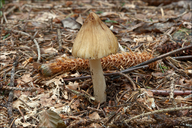date of photo Aug 16, 2014
latitude 46.40080 longitude 13.70181
View on Google Maps.
location
Zadnja Trenta valley, 'Zapodn' place, upstream from the last farmhouses, left bank of dry river bed of Soča, East Julian Alps (Posočje, Slovenia)notes Slo.: zašiljena razcepljenka - , syn.: Inocybe fastigiata (Schaeff.) Quell. - Habitat: bare ground in mixed forest, Picea abies and Fagus sylvatica dominant trees; under a group of large Picea abies; flat, raw humus rich, calcareous ground, old alluvium at the bottom of an alpine valley; in shade; partly protected from direct rain by tree canopies; average precipitations ~ 3.000 mm/year, average temperature 4-6 deg C, elevation 985 m (3.250 feet), alpine phytogeographical region. Substratum: soil. Comments: Inocybe is a huge genus with hundreds of mainly small, pale colored, mostly malodorous species. Arora (Ref.8) funnily describes them as follows: 'They come in an endless, senseless procession of boring browns, yucky yellows, gratuitous grays, and wishy-washy whites... Almost without exception they not only qualify as LBM's (Little-Brown-Mushroom), but also as BUM's (Boring-Ubiquitous-Mushrooms), and it is necessary to know the size and shape of the spores and cystidia before an accurate identification can be made. Even then, unraveling them is a trying and tedious task whose futility is only exceeded by its pointlessness, and underscored by the sad fact that most of them are poisonous'. Yet, Inocybe rimosa seems to me quite interesting. It is not difficult to recognize it although it is quite variable and actually a complex of varieties, which many of them are named even at higher taxonomical levels by some authors (look at picture 2M for the scatter of spore dimensions given by different authors). With the help of the key given in Krieglsteiner (2010) (Ref.4) even 'var. rimosa' was apparently easy to be determined. This name is legitimate according to MycoBank, however, Index Fungorum doesn't recognize it as a valid name and considers it as a synonym of Inocybe rimosa. Growing solitary; a single pileus found; cap diameter 5 cm, height 4.2 cm; stipe 12 cm long, 1 cm in diameter, fibrous, not hollow, twisted, and deeply rooted in ground; gills distinctly lemon-yellowish with slight green tint, oac6; after 24 hours being kept in refrigerator pale ocher-brown, oac717; SP pale ocher, oac688. Spores smooth, thick-walled. Dimensions: 10,6 [12 ; 12,6] 14 x 6,8 [7,5 ; 7,7] 8,4 microns; Q = 1,4 [1,6 ; 1,7] 1,9; N = 42; C = 95%; Me = 12,3 x 7,6 microns; Qe = 1,6. Olympus CH20, NEA 100x/1.25, magnification 1.000 x, oil, in water in vivo. AmScope MA500 digital camera. Ref.: (1) Personal communication with Mr. Bojan Rot, www.gobenabovskem.com. (2) S. Buczacki, Collins Fungi Guide, Collins (2012), p 368. (3) J. Breitenbach, F. Kraenzlin, Eds., Fungi of Switzerland, Vol.5., Verlag Mykologia (1991), p 76. (4) G.J. Krieglsteiner (Hrsg.), Die Grosspilze Baden-Württembergs, Band 5., Ulmer (2010), p 435. (5) M. Bon, Parey's Buch der Pilze, Kosmos (2005), p 234. (6) R. Phillips, Mushrooms, Macmillan (2006), p 219. (7) R.M. Daehncke, 1200 Pilze in Farbfotos, AT Verlag (2009), p 645. (8) D. Arora, Mushrooms Demystified, Ten Speed Press, Berkeley (1986), p 455.camera Nikon D700/Nikkor Micro 105mm/f2.8
contributor's ID # Bot_825/2014_DSC2871 photo category: Fungi - fungi
|
